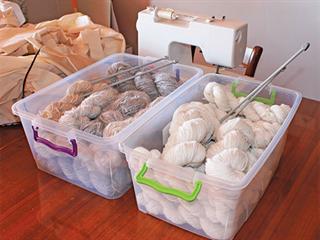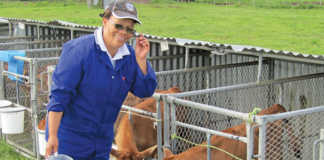
Based at Lion’s River in the KwaZulu-Natal Midlands, mother-and-daughter Angora rabbit and wool farming team Rosemary and Filia Dimitriades are fairly new to the business. But they are learning fast and their rabbitry is also growing at a swift pace. The Angora’s hair, or more correctly wool, is this rabbit’s ‘golden fleece’, providing for a high-end niche market worldwide.
Angora wool is seven times warmer than sheep’s wool, is exceptionally soft and silky and comes in a variety of natural colours. Adding to its appeal is the fact that Angora wool can be repeatedly and painlessly harvested from live rabbits, provided the technique is done correctly. In 2011 Rosemary, bored with retirement after farming sugarcane and free-range eggs with her husband, Dimitri, bought a breeding colony of five Angora rabbits from breeder Yolande Buhr, also from KwaZulu-Natal.
As she enjoyed handcrafting, Rosemary imagined that she would harvest the Angora wool and knit it into items for friends and family, or even sell some for pin money. But animal-loving Rosemary soon became enamoured of her small rabbit colony and bought 23 more Angora rabbits from Yolande in early 2012. She wanted to increase the colour varieties and needed new genes to prevent inbreeding.

Filia wears a beanie knitted partly from wool harvested from Juliet, the lilac chinchilla doe in her arms.
She was soon joined in her interest by Filia. “I’m a qualified teacher, but joined my mother managing the rabbitry and my father in running our ‘Gourmet Greek’ artisan cheeses and yoghurt production business,” says Filia.“Mom and I rescued 12 Angora rabbits from a backyard in Gauteng and then built a proper shed to house all the rabbits.” Today, there are between 90 and 100 Angora rabbits of different sexes and ages. Colour variations have exotic-sounding names such as black chinchilla, tortoiseshell, chocolate seal, frosted and cinnamon.
Individual housing
Dimitri designed and built a rabbit housing system in the 24m x 12m shed. Hygiene, space and rabbit welfare were his primary considerations in the design. “Angora rabbits are territorial and can be aggressive, so we have individual cages to prevent fighting and uncontrolled mating,” he explains. “Underneath the cages is a simple dung and urine drainage system that runs into plastic troughs at the end of each row. This keeps unpleasant smells and flies in the shed to a minimum and also helps to prevent germs spreading.”
Dung and urine troughs are emptied daily and flushed with water. The floor of the rabbitry is swept daily, and the drain system and floor are disinfected weekly. Dimitri has made the shed as rat- and mouse-proof as possible to prevent these rodents from spreading disease or biting the rabbits. The shed has 600mm high walls running its length and weld-mesh from the top of the walls to the roof eaves.
Temperature and ventilation are regulated through custom-made, height-adjustable, plastic curtains that can cover the weld-mesh if necessary. Filia explains that adult Angora rabbits are not too bothered by the Lion’s River winter temperatures that regularly drop below zero overnight. However, young rabbits (kits) born in winter – outside the preferred autumn and spring seasons – must be protected in nesting boxes until they have grown enough wool to insulate their bodies against the cold.
In summer, Angora rabbits can quickly get dangerously hot. To counter this, Rosemary and Filia open the shed’s curtains, set up electric fans to circulate the air and put ice in their drinking water. Water reaches each rabbit through a nipple-line system.
Feeding and health
Angora kits nurse from their mothers until they have been naturally weaned at six to eight weeks. This ensures that they get a good start. “Weaned rabbits are fed Meadow Feeds’ Complete Rabbit Feed, although the daily ration for each animal varies according to its age,” says Filia. “Adults get 120g a day. Once they are weaned, the rabbits get a daily ration of fresh grass, hay and a piece of fresh fruit or a vegetable. Pregnant and lactating does get oats, boiled potatoes and bran. Some foods – raw potato, avocado and the seeds of apples and pears, for example – are toxic to rabbits.”

The rabbitry currently houses 90 to 100 Angoras. Rosemary and Filia plan to have 200 by the end of 2014.
Each rabbit has a name and every cage a number. Details are stored on a data base and health and breeding status is monitored and recorded. “We name our rabbits because they’re special,” Filia says with a smile, while her more pragmatic father sits nearby shaking his head in disbelief. Angora rabbits are at high risk of developing wool block, a potentially fatal blockage in the digestive tract. This condition is caused when the rabbit, while grooming itself, ingests wool. Rabbits affected by wool block are treated as soon as possible.
The rabbits are dosed every three months with Ivomec oral to control internal and external parasites, such as wool mites. Sick rabbits are immediately medicated on-farm or, if necessary, taken to the Umgeni Veterinary Clinic in Hilton, about 20km away, for treatment. Angora rabbits are particularly prone to skin and eye infections because the wool absorbs moisture and urine readily and does not dry quickly. Rosemary and Filia therefore keep the animals as clean and dry as possible and treat infections promptly.
Breeding
Mating starts from 12 months. This ensures that a doe is mature before breeding and can provide one wool harvest before she births her first litter. “Mating decisions are based on wool quality and colour. We use a buck to enhance positive traits, and correct any weaknesses in a doe, through the offspring. We don’t put much emphasis on breeding rabbits to compete in shows, but we want to breed them to Angora rabbit breed standards so we can benefit from best quality wool. Breed standards don’t allow for white or pied patches on individual rabbits.”
An Angora rabbit doe is typically productive until five years old. Rosemary and Filia plan to prevent in-breeding by replacing bucks with different bloodlines from other Angora rabbit breeders. Bucks must be replaced every three to five years, depending on their health and how extensively they have been used in the colony. Angora does gestate for 28 to 32 days, and to ensure that the kits are not born in mid-winter, the Dimitriades mate their rabbits only in autumn and spring.
“Setting breeding seasons makes it easier to manage the colony’s health,” explains Filia. “If we allowed does to birth year-round, it would be more difficult. For mating, we always take a doe to a buck because the doe is territorial and can attack and perhaps injure a buck that moved into her cage. The pair spend an hour or more together, while we monitor them in case the doe starts attacking the buck. “Litter sizes in our colony vary from two to nine kits.”
Harvesting
Wool is carefully hand-plucked from the chest, back and sides of Angora rabbits. Filia says that a single adult typically produces about 300g of prime plucked wool every year. Good quality A-grade Angora rabbit wool of 12 to 16 microns currently sells for about R2 000/ kg. While B- and C-grade Angora rabbit wool sells for much less, it still fetches a higher price than sheep’s wool.
Rosemary and Filia are stockpiling Angora rabbit wool until they have enough to sell it as is, or to have it knitted into saleable value-added products. If the latter option is chosen, the business will offer casual employment to local elderly citizens.
“Farming Angora rabbits is very rewarding but these rabbits require intensive care,” admits Filia. “In particular, they need grooming to prevent their wool from becoming matted with urine, dung and dirt.
And it’s also necessary to make sure they don’t get ill.
“For children wanting a rabbit as a pet, I’d recommend a breed bred specially as a pet, not the Angora.” She adds that although Angora rabbit wool products are appealing, she would never recommend harvesting Angora rabbits as a primary income. “We farm Angora rabbits because we have a passion for the animals and their wool,” she says.
Rosemary and Filia aim to have about 200 Angora rabbits by the end of 2014.
Phone Rosemary or Filia Dimitriades on 033 234 4338 or email [email protected].













